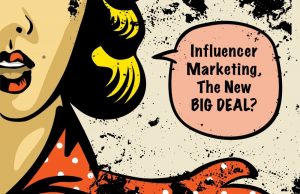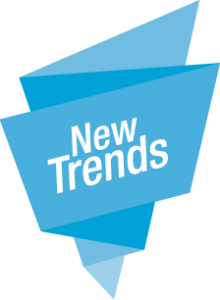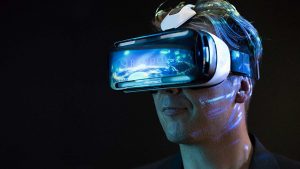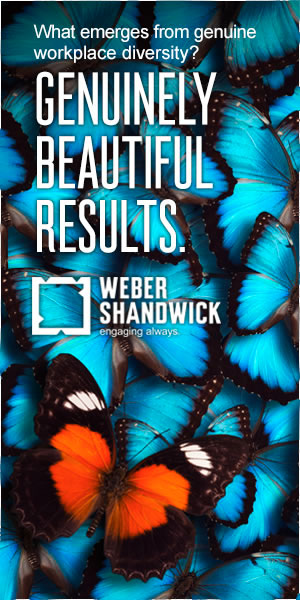As we enter 2017, many wonder what advertising and marketing trends we should keep an eye on.
Last month, several agencies released reports with their predictions in December so we decided to ask a few to share their thoughts with us.
DIVERGE talked to agencies including DigitasLBi, FleishmanHillard, RED Interactive Agency, sparks & honey and Carusele to find out their predictions for 2017.

Image: MarketingTech Blog
DIVERGE: Do you think influencer marketing is an upcoming trend for 2017?
Jill Sherman, the SVP of Social Strategy at DigitasLBi:
Twitter killed Vine. Snapchat killed auto play. And YouTube’s latest algorithm update is allegedly impacting some of its major players, like PewDiePie. Until now, these changes have been taking place without warning. As a result, influencers aren’t happy—many threatening to cancel or move their accounts elsewhere. These overnight drops in followers, video views (and loss of entire platforms!) are most negatively impacting the very people who draw millions to the platforms each day. As a result, 2017 will see top influencers banding together to secure a seat at the table to inform decisions that are being made. Because it’s not just their reputations—but their livelihoods—on the line.
Dan Stevens, Global Managing Director, Consumer Sector for FleishmanHillard:
Influencer marketing is definitely a growing trend for 2017. The trust and endorsement value of influencers in consumer marketing is hard to match with branded content alone.
Brands that have limited points of dialog with their consumers will look to influencers to be their surrogates. But influencers can’t drive brand love if they don’t have it themselves.
Brian Lovell, RED Interactive Agency’s CEO:
Influencer marketing will continue to grow in 2017 simply because it’s proven effective and influencers have what all brands covet, the trust and attention of the customer. As marketing dollars continue to pour into this channel, I think we will see influencers becoming very savvy content creators and this could open the door to all types of new and interesting branded content possibilities.
Brian Pham, Associate Director of Social Media at sparks & honey:
The growth of influencer marketing is certain for 2017, and has been a staple in the world of advertising and essential brands for years. As platforms continue to develop their capabilities, influencers will be the first to develop the innovative ways to utilize new tools and formats; they will continues to be a one stop shop for creative execution and distribution. They are in the forefront of digital entertainment, they understand trends, culture, and most importantly how to capture an audience; which are often challenges for brands.
Jim Tobin, CEO of Carusele:
Overall, we believe that influencer marketing will continue to gain momentum as small and large brands alike recognize it is not only a cost-effective way to communicate with their customers, but also a uniquely targeted method that delivers their branded content to audiences that have been difficult to reach. The proven ROI of influencer marketing will attract more and more converts and will ultimately see influencer marketing as a mainstream way for brands to deliver their message.

DIVERGE: How do you think influencer marketing will affect marketing?
Dan Stevens, Global Managing Director, Consumer Sector for FleishmanHillard:
As brands and retailers continue looking for new digital tools and content strategies to engage with their customers and drive to e-commerce sites, they’ll look to influencers to help shape those experiences. In 2017, we expect to see brands integrating influencers into more parts of their campaigns and for longer portions of the campaigns.
Brian Lovell, RED Interactive Agency’s CEO:
For most brands, influencer marketing is one important piece of the overall marketing mix. I wouldn’t expect this to change anytime soon. However because of its effectiveness, especially when connecting with younger audiences, it makes sense that we will see a brands “influencer strategy” become a higher priority in the overall marketing mix.
Brian Pham, Associate Director of Social Media at sparks & honey:
Influencers and Celebrities has increasingly become a bigger part of the holistic marketing plan, brand marketers will look to utilize influencers to their full potential. The voice of influencers need to align with the brand’s message to make impact, in 2017 we’ll see brands letting go of some control and let influencers utilize their voice to their full abilities. The relationship between brands and their ambassadors will be more integrated to ensures in the larger scheme of things, the influencers are complementary to brand and not just another reach arm.
Jim Tobin, CEO of Carusele:
We’ll see more brands recognizing that significant and measurable business results come from conducting campaigns with targeted and authentic micro-influencers (rather than spending/wasting big bucks on celebs). We’ll see further fragmentation of the industry – as brands and influencers alike wrestle with what is worth what, how much they should be paying/charging and how to give up a certain degree of control in order to both satisfy the FTC and get content that actually resonates with the audiences they’re trying to reach.

Will companies spend more money on social media marketing and live video?
Jill Sherman, the SVP of Social Strategy at DigitasLBi:
Gen Z will continue changing up the social game by caring less about the “curated self” and “broadcasted self” and more about in-the-moment experiences. Live social networks, like YouNow, Music.ly, Watch Me Work, and Live.ly will continue to grow with younger users by connecting them to people, places and things in real time. Think studying, jamming on instruments, debating politics or being a fly on the wall. For them, it’s less about the ability to broadcast live, and more about the ability to utilize live media to connect with others around moments.
Jim Tobin, CEO of Carusele:
2016 saw heavy emphasis on live streaming. Heck, Facebook even sprung for TV commercials to convince people to use Facebook Live and Instagram added live video in November. It’s been interesting to watch how it has rolled out and taken hold. It’s getting significant engagement because Facebook has been prioritizing live streams by sending notifications when anyone goes live.
In 2017, we’ll see the continuation of this trend and, as long as Facebook keeps prioritizing it, live streams will deliver outsized results. When newsfeeds become too crowded though, Facebook will start to back off. By then, it will be more mainstream and influencers and brands alike will be comfortable incorporating it into campaigns.*
Brian Lovell, RED Interactive Agency’s CEO:
In 2017 we expect brands to spend more money on social media marketing and live video, especially when it comes to connecting with the millennial audiences. E-marketer suggests that one-quarter of all ad spending will be focused on social platforms. And that the overall spend could top 19 Billion. That’s mind blowing.
Brian Pham: Associate Director of Social Media at sparks & honey:
Media spend on social platforms will continue to steadily grow and often influencer marketing will be part of the overall social budgets, as they should be integrated together versus soloed apart. Live video will be a content activation that will continue to grow especially as platforms continue to build out that capabilities and users start to use instant video more consistently. We may begin to see influencers take a larger percentage of the overall budget, they provide the mix of content and distribution; as brands look to stretch their dollars more than ever.

What are some other trends that we will see in 2017?
Jill Sherman, the SVP of Social Strategy at DigitasLBi:
A Push for Social Platform Governance
Thanks to alleged election shenanigans, like Russians posing as Americans, bots posing as humans, and a disproportionate amount of news in our feeds coming from fake news sources, politicians, media watchdogs and Internet governance groups will spend 2017 pushing for rules that will go into effect in 2018. Algorithms will need to be more democratic, bots will no longer be able to pose as real people, influencer relationships will require even greater transparency and social platforms will be held to media outlet standards.
A New Era of Data Accountability
2017 headlines like referrer spam, exaggerated ad data, and miscalculated metrics rocked digital media giants like Google and Facebook. And, while they were quick to take full responsibility—even going directly to the press on several occasions—the ability for these giants to have greater third party oversight is now an industry-wide topic of conversation.
Bots Reach Far Beyond Entertainment
A recent DigitasLBi study revealed that one in three Americans would be willing to make purchases via chat bots. And nearly half of millennials have or would be willing to receive recommendations from a chat bot. Surprisingly, only a tiny fraction of bots currently play a meaningful role in ecommerce. And those that do are limited to customer service activities. With consumers now more open to a commerce-by-bot experience, expect to see bots playing a greater commerce role in 2017.
Jim Tobin, CEO of Carusele:
Native Advertising Will Dominate 2017
We expect to see an uptick in brands and consumers reaping the benefits from good native advertising and influencer campaigns – more and more, regular people will inspire others to use a product, they’ll see new ways to use it that are exciting, brands will develop ambassador relationships with influencers, and consumers will come to prefer and potentially rely on the recommendations of people that they trust more than brands themselves. Particularly as ad blockers continue to gain strength, it will become increasingly difficult to get a brand message through using traditional media.
Budgets will continue to increase:
Adweek predicts that overall influencer marketing budgets will double in the next 12 months –something that validates what we’ve been saying all along. Influencer campaigns work. As brands will devote more of their marketing dollars to influencer led campaigns, these larger budgets will mean more campaigns and more influencers being employed. Budgets will increase because influencer campaigns deliver much more bang for the buck than traditional digital marketing – and the ROI for influencer campaigns continues to be favorable.*
The Renewed Emphasis on Organic Reach:
Organic reach will continue to be important for brands. While it is definitely more and more difficult to achieve, it’s still important because it allows brands to test their content before spending money to boost it. Those who understand that organic reach is not an end, but a means to an end, will save more than 50% on their boosting budgets
Brian Lovell, RED Interactive Agency’s CEO:
Personalization:
Brands are taking more control of their data and using it to better understand their customers. This allows a brand to create more personalized experiences based on the specific customer needs and preferences. Personalization can have a huge impact on the quality and relevance of campaign messaging, content creation, Website and app performance, social platform engagement and even in-store experiences.
Internet of Things:
The IOT continues to offer infinite possibilities to create meaningful and connected experiences that improve people’s lives. More and more products are smart (connected to the internet) and according to Park and Associates, the average US household already owns an average of 8 connected computing, entertainment, mobile and home devices. Some Industries we expect to lead the way with new connected IOT experiences this year are consumer electronics, automotive, healthcare and the wearable/apparel industries.
Brian Pham: Associate Director of Social Media at sparks & honey:
Sparks and Honey has defined 100 trends to look out for in 2017 that touches on everything from tech and science to ideologies in the latest “A-Z Culture Glossary 2017.” A few trends have touched upon what you have been alluding to in your questions such as “Broadcast Social” and “Brand Built World.” Broadcast Social is a growing trend that will grow vastly in 2017, the shift of broadcast is now in the hands of the mass through social platforms. Broadcast will no longer live strictly on TV, but has transitioned to mobile for viewers and the creators.
The rise of broadcast provides another content outlet for brands. Brands are becoming an essential part of culture, they need to become entertainers to impact the mass and resonate with audiences. As brands rise take on this new role as an entertainer, their core business they will begin to play a bigger role in society that could include advocacy, tech, and even infrastructure

EDITOR’S NOTE: Virtual Reality and Augmented Reality: This was a subject that came up constantly as a trend that would continue: DIVERGE will post a dedicated piece regarding this later in the week.

